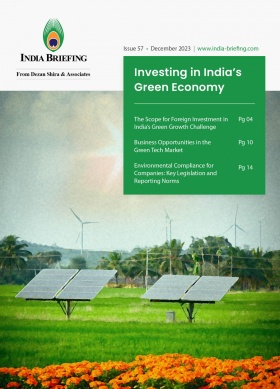Import and Export Procedures in India
As India seeks to boost two-way trade, we discuss the import and export procedures, including updates under the Foreign Trade Policy 2023. A key goal for authorities is trade facilitation to streamline trade compliance and customs procedures – part of the broader India@2047 blueprint, which aims to elevate India’s global trade share to 10 percent by 2047.
Businesses planning to set up a trading company, or start importing or exporting from India, must understand the stages and stakeholders involved in the process, as well as the regulatory framework and documentation required.
In India, imports and exports are regulated by the Foreign Trade (Development and Regulation) Act, 1992, which empowers the federal government to make provisions for the development and regulation of foreign trade. The current provisions relating to exports and imports in India are available under the Foreign Trade Policy, 2023.
India introduces new export classification system
On January 13, 2025, India’s Directorate General of Foreign Trade (DGFT) updated the export policy under Schedule-II, aligning it with the Finance Act 2024. The revised policy now covers all Indian Trade Classification (Harmonized System), ITC (HS), codes and introduces item-specific conditions even for goods previously under general classification.
The move standardizes classification using the globally accepted 8-digit ITC-HS code, replacing the earlier description-based system. This aims to streamline export procedures, reduce ambiguity, and enhance compliance.
The DGFT also categorized goods under the following classifications:
- Free: No license required;
- Restricted: Requires an export license;
- Prohibited: Not eligible for export; and
- State Trading Enterprises (STEs): Exportable only through designated STEs.
Special Chemicals, Organisms, Materials, Equipment, and Technologies (SCOMET) items and other legally regulated goods remain governed by separate provisions. The update helps improve transparency and consistency across India’s trade system. India uses an eight-digit ITC-HS code to classify all merchandise goods under both import and export frameworks:
- Schedule I governs import rules and policies; and
- Schedule II governs export rules and policies.
Import procedures
Typically, the procedure for import and export activities involves ensuring licensing and compliance before the shipping of goods, arranging for transport and warehousing after the unloading of goods, getting customs clearance and paying taxes before the release of goods.
Below, we outline the steps involved in importing goods.
1. Obtain e-IEC
Prior to importing from India, every business must first obtain an electronic Import Export Code (IEC), a 10-digit number, from the Directorate General of Foreign Trade (DGFT). IEC is mandatorily required for clearing customs, sending shipments, and sending or receiving money in foreign currency. However, it is not necessary for service exports unless the service provider is seeking benefits under the Foreign Trade Policy.
Documents required for an IEC application
Scanned documents for upload in the system:
a) Proof of establishment/incorporation/registration:
- Partnership
- Registered Society
- Trust
- Hindu Undivided Family
- Others
b) Proof of address can be any one of the following documents:
- Sale Deed, rent agreement, lease deed, electricity bill, telephone land line bill, mobile, postpaid bill, MoU, Partnership deed.
- Other acceptable documents (for proprietorship only): Aadhar card, passport, voter ID.
- In case the address proof is not in the name of the applicant firm, a no objection certificate (NOC) by the firm premises owner in favor of the firm along with the address proof is to be submitted as a single PDF document.
c) Proof of firm’s bank account
- Cancelled check
- Bank certificate
During the import-export code registration process, the DGFT instantly confirms all information with the Income Tax Department. This means that the IEC certificate can be generated in a single day. Prior to 2021, an IEC certificate was valid for the entire length of that business. However, this was later changed in a notification sent out in February 2021 which made IEC renewal necessary. This notice states that every holder of an IEC number has to renew their IEC certificate annually between April and June.
2. Ensure legal compliance under different trade laws
Once an IEC is allotted, businesses may import goods that are compliant with Section 11 of the Customs Act (1962), Foreign Trade (Development & Regulation) Act (1992), and the Foreign Trade Policy, 2023.
However, certain items – not covered by an Open General License, are subject to regulation and can be divided into three categories: items that are restricted and require an import license; items that are banned or prohibited; and items that are “canalized,” meaning that only government-led companies are allowed to import them and that timing and quantity approval from the cabinet are required.
3. Procure import licenses
To determine whether a license is needed to import a particular commercial product or service, an importer must first classify the item by identifying its Indian Trading Clarification based on a Harmonized System of Coding or ITC (HS) classification.
ITC (HS) is India’s chief method of classifying items for trade and import-export operations. The ITC-HS code, issued by the DGFT, is an 8-digit alphanumeric code representing a certain class or category of goods, which allows the importer to follow regulations concerned with those goods. Within the 8-digit code, the first 6-digit are common as per the World Customs Organisation (WCO) with an additional 2-digit for added specificity.
It is significant to note that the ITC (HS) Schedule I and Schedule II, respectively, outline the item-by-item import/export policy. The policy in effect on the date of import or export determines an item’s importability and exportability.
An import license may be either a general license or specific license. Under a general license, goods can be imported from any country, whereas a specific or individual license authorizes import only from specific countries.
Import licenses are used in import clearance, renewable, and typically valid for 24 months for capital goods or 18 months for raw materials components, consumables, and spare parts.
4. File Bill of Entry and other documents to complete customs clearing formalities
After obtaining import licenses, importers are required to furnish an import declaration in the prescribed Bill of Entry along with permanent account number (PAN) based Business Identification Number (BIN), as per Section 46 of the Customs Act (1962).
A Bill of Entry gives information on the exact nature, precise quantity, and value of goods that have landed or entered inwards in the country.
If the goods are cleared through the Electronic Data Interchange (EDI) system, no formal Bill of Entry is filed as it is generated in the computer system. However, the importer must file a cargo declaration after prescribing particulars required for processing of the entry for customs clearance.
If the Bill of Entry is filed without using the EDI system, the importer is required to submit supporting documents that include certificate of origin, certificate of inspection, bill of exchange, commercial invoice cum packing list, among others.
Once the goods are shipped, the customs officials examine and assess the information furnished in the bill of entry and match it with the imported items. If there are no irregularities, the officials issue a ‘pass out order’ that allows the imported goods to be replaced from the customs.
5. Determine import duty rate for clearance of goods
India levies basic customs duty on imported goods, as specified in the first schedule of the Customs tariff Act, 1975, along with goods-specific duties such as anti-dumping duty, safeguard duty, and social welfare surcharge.
In addition to these, the government levies an integrated goods and services tax (IGST) under the new GST system. The IGST rates depend on the classification of imported goods as specified in Schedules notified under Section 5 of the IGST Act (2017).
Export procedures
Just as for imports, a company planning to engage in export activities is required to obtain an IEC number from the regional joint DGFT. After obtaining the IEC, the exporter needs to ensure that all the legal compliance requirements are met under different trade laws.
Further, the exporter must check if an export license is required, and accordingly apply for the license to the DGFT.
An exporter is also required to register with the Indian Chamber of Commerce (ICC), which issues the Non-Preferential Certificates of Origin certifying that the exported goods are originated in India.
In 2023, the DGFT launched the Advance Authorisation Scheme under the Foreign Trade Policy, enabling duty-free import of inputs for export. The eligibility of inputs is determined by Sector-specific Norms Committees based on input-output norms. The scheme offers a grace period for exporters who, as holders of Advance and EPCG (Export Promotion for Capital Goods) Authorizations, default on their export obligations once.
Import and export documents
Businesses are required to submit a set of documents for carrying out export and import activities in India.
These include commercial documents – the ones exchanged between the buyer and seller, and regulatory documents that deal with various regulatory authorities such as the customs, excise, and licensing authorities, as well as the export promotion bodies that help avail export import benefits.
The Foreign Trade Policy, 2023 mandates the following commercial documents for carrying out importing and exporting activities:
|
For export of goods from India |
For import of goods into India |
|
1. Bill of Lading/ Airway Bill/ Lorry Receipt/ Railway Receipt/ Postal Receipt 2. Commercial Invoice cum Packing List* 3. Shipping Bill/Bill of Export/ Postal Bill of Export |
1. Bill of Lading/Airway Bill/ Lorry Receipt/ Railway Receipt/ Postal Receipt in form CN-22 or CN 23 as the case may be. 2. Commercial Invoice cum Packing List** 3. Bill of Entry |
Additional documents like certificate of origin and inspection certificate may be required as per the case.
The important regulatory documents include:
- GST return forms (GSTR 1 and GSTR 2);
- GSTR refund form;
- Exchange Control Declaration;
- Bank Realization Certificate; and
- Registration cum Membership Certificate (RCMC).
In accordance with the foreign trade policy, exporters need a RCMC to access policy benefits. Having this certificate also enables exporters to avail advantages related to customs and excise. Export promotion councils and commodity boards are the entities responsible for issuing this certificate.
Launch of the Indian Customs Compliance Information Portal
The Central Board for Indirect Taxes and Customs (CBIC) launched the Indian Customs Compliance Information Portal (CIP) in 2021 to provide free access to information on all Customs procedures and regulatory compliance for nearly 12,000 Customs Tariff Items.
The CIP is a facilitation tool that allows interested persons to stay up-to-date with information on the legal and procedural requirements of India’s customs authorities and regulatory government agencies (FSSAI, AQIS, PQIS, Drug Controller, etc.) for carrying out imports and exports. The portal will provide complete knowledge of all import and export-related requirements for all items covered under the Customs Tariff, thereby improving the ease of doing cross border trade.
When using the CIP portal, one can simply enter either the Customs Tariff Heading (CTH) or the description of the goods in question to get information on step-by-step procedures, regulatory compliances requirements like license, certificates, etc., for imports as well as exports. This includes import and export through posts and courier, import of samples, reimport and reexport of goods, self-sealing facility for exporters and project imports.
Another important feature of the CIP is a pan India map showing all the Customs seaports, airports, and land customs stations etc. It also contains addresses of the regulatory agencies and their websites.
Various measures taken by India for promotion of exports
- Establishment of Foreign Trade Policy 2023.
- Schemes, such as the Advance Authorization Scheme and the Export Promotion Capital Goods (EPCG) Scheme (see PDF link here), to enable duty free import of raw materials and capital goods for export oriented production. To apply for Advance Authorization Scheme, see the relevant DGFT page here.
- The Interest Equalization Scheme, which provides pre- and post-shipment Rupee export credit, and has been extended up to September 30, 2021.
- Remission of Duties and Taxes on Exported Products (RoDTEP) scheme, operationalized for exports with effect from January 1, 2021.
- Extension of the Rebate of State and Central Levies and Taxes (RoSCTL) Scheme for apparel and made-up exports till March 2024.
- Transport and Marketing Assistance (TMA) scheme for specified agriculture products, which provides assistance for the international component of freight and marketing of agricultural produce and to promote brand recognition for Indian agricultural products in specified overseas markets. To apply for TMA Scheme, see the relevant DGFT page here.
- A Common Digital Platform for Issuance of Certificates of Origin (CoO) has been launched to increase Free Trade Agreement (FTA) utilization by exporters ⟶ https://coo.dgft.gov.in
As of 2023, Certificates of Origin (CoO) for Preferential Trade Agreements, FTA, Comprehensive Economic Cooperation Agreements, and Comprehensive Economic Partnerships Agreements are issued designated agencies. This has been notified in the Appendices & Aayat Niryat Forms of the Foreign Trade Policy, 2023.
- Districts across India are being promoted as Exports Hubs by identifying products and services with export potential in each district (One District One Product / ODOP initiative), addressing bottlenecks for exporting these products/services and supporting such local exporters/manufacturers through institutional and strategic interventions. District specific export action plans for 478 districts have been prepared. To see the One District One Product Digital GIS Map on the Ministry of Food Processing Industries website, click here. The Department of Commerce is focusing on agriculture crops via a cluster approach for support for exports under the Agriculture Export Policy. This complements the cluster approach for the development of specific agriproducts in districts having a comparative advantage by the Ministry of Agriculture.
- Market Access Initiative (MAI) Scheme is an Export Promotion Scheme that provides financial assistance to eligible agencies like Export Promotion Organizations/Trade Promotion Organizations/National Level Institutions/ Research Institutions/Universities/Laboratories, Exporters etc. The scheme is formulated on focus product-focus country approach to evolve specific market and specific product through market studies/survey.
- A working group on infrastructure upgradation has been constituted under National Committee on Trade Facilitation (NCTF) and a National Trade Facilitation Action Plan (NTFAP) has been formulated. This includes measures for improving road and rail connectivity to ports and smart gates at sea ports.
The Customs CBIC has undertaken numerous initiatives to facilitate import and export, such as:
- 24X7 Customs clearance in 20 seaports and 17 airports and extended clearance in ICDs as per the needs of the trade.
- Single Window in Customs
- E-Sanchit – Enabling Paperless clearance environment.
- Pan-India Implementation of Faceless e-Assessment in imports.
- TURANT Customs
- Implementation of electronic messages from Document Clearance to Cargo Movement
- Paperless Customs initiatives –Preparation and issuance of electronic documents like e-LEO SB, e-Gatepass/e-OOC, etc.,
- Contactless customs initiatives such as Turant Suvidha Kendras (TKSs).
- Release of ICE-DASH–Indian Customs EoDB Monitoring Dashboard
- Direct Port Delivery (DPD) on imports and Direct Port Entry (DPE) on exports
- Compliance Information Portal (CIP)
- End to End automated and simplified procedure for the import of certain specified Goods at Concessional Rate of Duty or for specified end use.
Outlook
India is working on streamlining approvals to ensure that goods for exports and imports are cleared within an hour of their arrival at seaports and airports to help catapult India’s share in global trade to 10 percent in the coming decades. The ‘customs ONE’ plan prepared by the Department of Commerce, Government of India, is part of the India@2047 blueprint, a vision to make the country one of the world’s top three economies and achieve developed nation status by the 100th year of its independence.
Citing the National Time Release Study 2022, the Central Board of Indirect Taxes and Customs (CBIC) says that the average time required for import customs clearance has decreased by 12 percent at seaports and by 16 percent at air cargo complexes.
This article was originally published in August 2019. It was updated on April 11, 2025.
(With inputs from Sudhanshu Singh)
About Us
India Briefing is one of five regional publications under the Asia Briefing brand. It is supported by Dezan Shira & Associates, a pan-Asia, multi-disciplinary professional services firm that assists foreign investors throughout Asia, including through offices in Delhi, Mumbai, and Bengaluru in India. Readers may write to india@dezshira.com for support on doing business in India. For a complimentary subscription to India Briefing’s content products, please click here.
Dezan Shira & Associates also maintains offices or has alliance partners assisting foreign investors in China, Hong Kong SAR, Dubai (UAE), Indonesia, Singapore, Vietnam, Philippines, Malaysia, Thailand, Bangladesh, Italy, Germany, the United States, and Australia.
About us
India Briefing is produced by Dezan Shira & Associates. The firm assists foreign investors throughout Asia from offices across the world, including in Delhi and Mumbai. Readers may write to india@dezshira.com for more support on doing business in India.
We also maintain offices or have alliance partners assisting foreign investors in Indonesia, Singapore, Vietnam, Philippines, Malaysia, Thailand, Bangladesh, Italy, Germany, Australia, and the United States.
- Previous Article India Gains Temporary Relief as Trump Suspends Reciprocal Tariffs for 90 Days
- Next Article Corporate Taxation and Compliance Regime in India








